Biography
Interests
Guljaš Silva1, Trtica Majnarić Ljiljana2,3* & Tamer Salha2,4
1Department of Clinical Radiology, UHC Osijek, Croatia
2Faculty of Medicine of JJ Strossmayer University of Osijek, Osijek, Croatia
3Faculty of Dental Medicine and Health of JJ Strossmayer of Osijek, Osijek, Croatia
4The Health Center Osijek, Osijek, Croatia
*Correspondence to: Dr. Trtica Majnarić Ljiljana, Faculty of Medicine & Faculty of Dental Medicine and Health of JJ Strossmayer University of Osijek, Osijek, Croatia.
Copyright © 2020 Dr. Trtica Majnarić Ljiljana, et al. This is an open access article distributed under the Creative Commons Attribution License, which permits unrestricted use, distribution, and reproduction in any medium, provided the original work is properly cited.
Abstract
Currently in times of COVID 19 pandemic many employed people are confined to their homes and social interaction takes place through social networks and mobile phones. Many study report about impact of pandemic on mental health in elderly population but little is known about the association between the use of social network and mobile phone and social isolation in employed people. This survey was conducted in 2020, in the town of Osijek region, eastern Croatia, and included 63 young employed people, 16 men, 46 woman, the age range of 27-64 years, who work at different work places and education levels.
An increase in communication via social networks, e-mails, and mobile phones, has been noticed in 52,4% respondents. Most of respondents, 58,7%, fight feeling of loneliness with personal activities away from online, 22,2% of them use the cell phone conversations, and 19% use the social networks.
Viber is the most used way of online communication used by 58,1% of respondents, followed by WhatsApp, used by 22,6% respondents.
Regarding changes that they noticed on themselves, 65,3% of respondents have noticed negative changes on their mental health.
Social isolation and feeling of loneliness that comes with it directs people away from actual circumstances to virtual environments where they find comfort and apparent feeling of connection and inclusion in society but it cannot replace real socializing and communication completely.
Introduction
The effects of the coronavirus disease 2019 (COVID-19) upon mental health is dramatic. Many people
regardless old age experience anxiety and loneliness.
In time before COVID 19 pandemic started, social media, on line communication and lack of inperson communication between individuals as a consequence of technological development was a major problem and an everyday topic of discussion.
However, currently in times of COVID 19 pandemic there are recommendation of social distancing measures in order to prevent viral transmission so social media and online communication come as a possible saviour [1].
The elderly population experience social isolation and loneliness as a consequence of death or family migration and many study encourages the use of modern technology like social media or video calls to help them cope with loneliness. Capabilities of internet open up to elderly a virtual world where they can communicate with family, make new friends or occupy their time with many interesting content available online [2].
Social isolation (an absence of social connections) and loneliness (subjective dissatisfaction with relationships) are distinct conditions but both of them contribute to cognitive decline, depression, premature mortality and cardiovascular disease [3,4].
Many employed people are currently confined to their homes, feeling suddenly detached from everyday dynamic lifestyle and social life.
In such circumstances social interaction takes place through social networks and mobile phones.
Some studies showed a positive association between the use of social network sites and loneliness among younger adults in different countries which reflects discrepancy between actual and desired social relationships [5,6].
On the contrary, some people who see themselves as socially isolated may feel less isolated when using social networks as these sites may help built social contacts [7,8].
Many study report about impact of pandemic on mental health, social isolation and loneliness in elderly population but little is known about the association between the use of social network and mobile phone and social isolation in employed people so the aim of the present study was to examine this association.
Some research show that loneliness appears to vary with employment status. Employed young adults have been observed to be less lonely than their unemployed counterparts [9]. Employment is expected to be associated with lower levels of loneliness because of business social contact, feeling of purpose, status, and activity [10]. However, employment may also result in higher levels of loneliness because it restricts one’s available free time and thereby may be associated with fewer interactions with friends and family. Also across the life span, work status may be a particularly strong predictor of loneliness during the period in which having a job is the norm, that is, between 30 and 65 years.
Social media tools such as Facebook, Twitter, Instagram, Viber and WhatsApp offer their millions of users the chance to communicate, get in touch, access information and chat [11].
Methods
This survey was conducted in 2020. and includes 63 young employed people, 16 men, 46 woman, the age
range of 27-64 years who work at different work places and education levels from jobs that require finished
only high school to jobs that require finished college.
Questionnaire was used as survey instrument, which was distributed through electronic mail, Facebook messenger, Viber and WhatsApp messenger using Google forms.
First part of questioner consisted of questions aimed to obtain information on demographic and workplace: age, gender and profession.
Second part of questioner consisted of two parts of questions. The first part questions obtaining information on personal life like a change in family relations compared to time before pandemic, the most relevant chances they noticed, how they fight feelings of loneliness and do they find feeling of loneliness and social isolation as distinct conditions. The second part obtaining information about their habit of using social networks and instant messengers like which social network/instant messenger they use the most for communication, whether their communication via social networks has changed compared to time before pandemic and whether they could communicate permanently only through social networks.
Results
The median age of the respondents was (interquartile range 27-64). There was more woman than man,
74,2% woman, 25,8% man.
Regarding their communication via social networks, e-mails and mobile phones compared to the same period last year before the pandemic 52,4% respondents think it has increased and 46% of them answered it stayed the same. Only 1,6% of them think it has decreased.
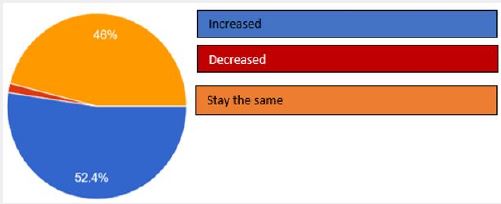
None of the correspondents could permanently replace in person communication with friends with online communication, but regarding the circumstances 81% could do that for a short period of time and 19% of them already feel lonely in lack of in person communication.
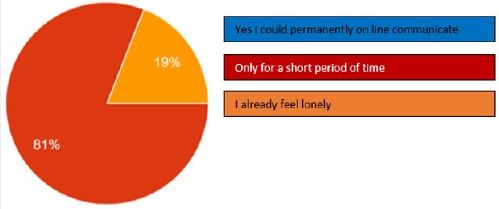
Compared to time before the pandemic, the relationships in their family have become closer for 15,9% respondents, got worse for 6,3% and 77,8% has noticed no change in family relations.

Feeling of loneliness and social isolation equalizes 14,3% of respondents and 85,7% of them perceives them as discinct conditions.
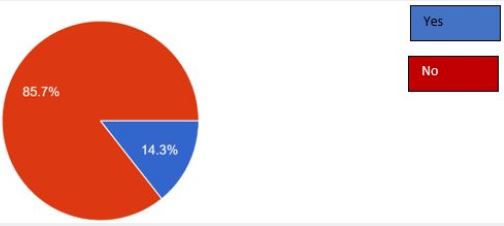
Most of respondents, 58,7% of them, fight feeling of loneliness with personal activities away from online communication like reading, learning or sport. Cell phone conversations is help for 22,2% of respondents and 19% of respondents uses social networks.
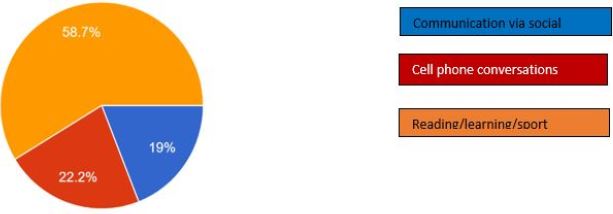
Viber is the most used way of online communication used by 58,1% of respondents, followed by WhatsApp used by 22,6% respondents. Facebook messenger uses 16,1%, Twitter and Instagram 1,6% of them. Snapchat and BBM enterprise none of them uses.
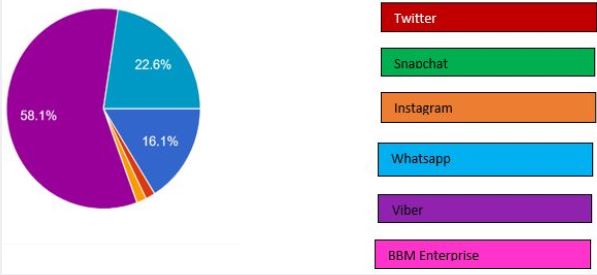
When asked about changes they have noticed regarding their physical appearance or mental health in long sentence answers most, 65,3% of them, answered that they have noticed some negative changes regarding mental health like fear, social isolation, depression, sadness, anxiety, need to be in nature. On contrary 2,5% have noticed significant changes in their appearance like getting weight or lack of will to beautify themselves.
Discussion
Social isolation and feeling of loneliness that comes with it directs people away from actual circumstances
to virtual environments where they find comfort and apparent feeling of connection and inclusion in society
[12].
On the other hand all forms of virtual communication take people away from real life and intimacy of in person communication. With online communication they cannot create memories and get fulfillment that in person communication brings. Except for a brief sense of social connection, bad impact on mental health and increased feeling of loneliness with virtual communication cannot be denied [13-15]. Consequently, a large number of people prefer to spend time in their own activities such as sport, reading or walking in nature [16,17].
Conclusion
In conclusion, virtual communication provides a certain sense of closeness and in this time of COVID-19
pandemic and necessary social isolation it certainly helps to reduce anxiety and loneliness, by keeping in
touch with each other, but it cannot replace real socializing and communication completely. Especially in
employed population which has, regarding the circumstances, changed dynamic lifestyle and everyday in
person communication overnight.
Bibliography

Hi!
We're here to answer your questions!
Send us a message via Whatsapp, and we'll reply the moment we're available!